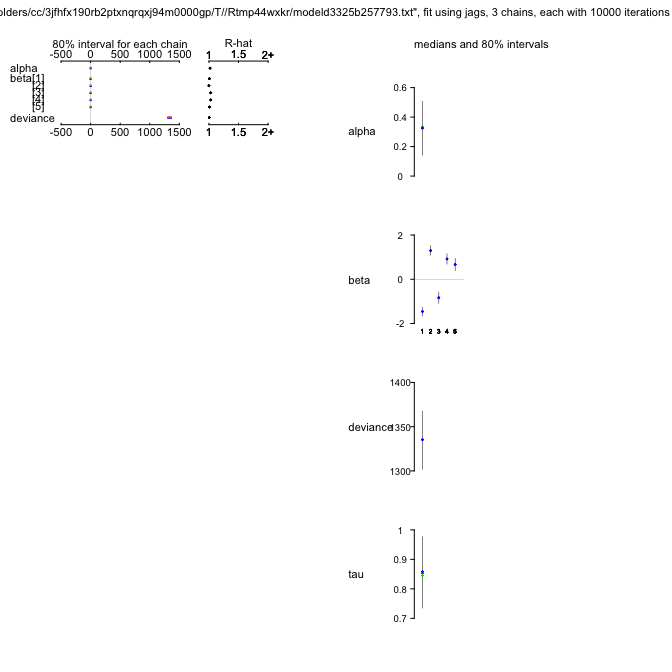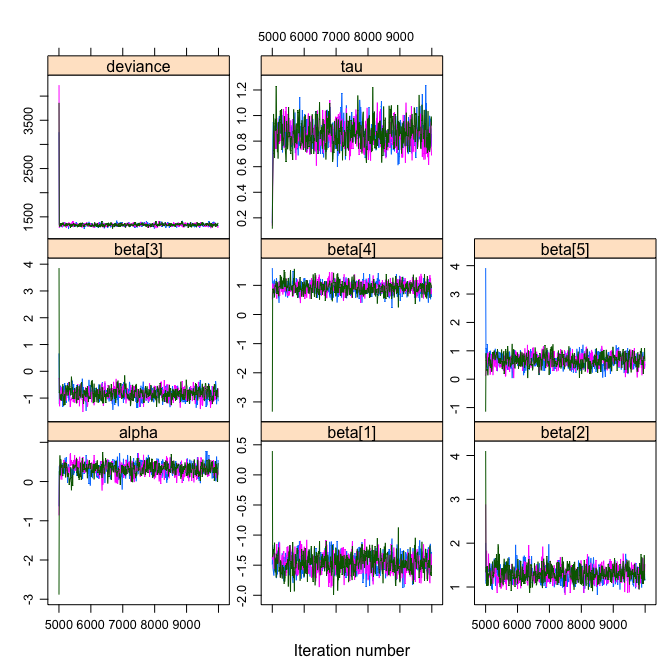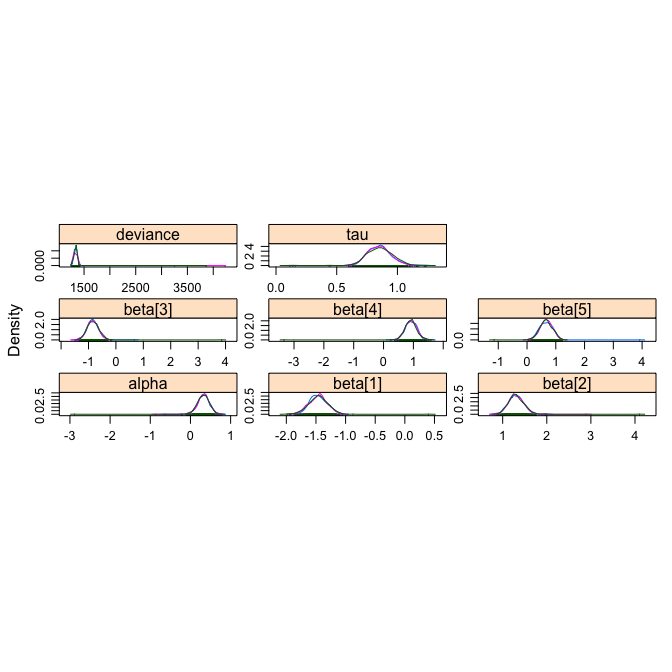Introduction: what is overdispersion?
Overdispersion describes the observation that variation is higher than would be expected. Some distributions do not have a parameter to fit variability of the observation. For example, the normal distribution does that through the parameter $\sigma$ (i.e. the standard deviation of the model), which is constant in a typical regression. In contrast, the Poisson distribution has no such parameter, and in fact the variance increases with the mean (i.e. the variance and the mean have the same value). In this latter case, for an expected value of $E(y)= 5$, we also expect that the variance of observed data points is $5$. But what if it is not? What if the observed variance is much higher, i.e. if the data are overdispersed? (Note that it could also be lower, underdispersed. This is less often the case, and not all approaches below allow for modelling underdispersion, but some do.)
Overdispersion arises in different ways, most commonly through “clumping”. Imagine the number of seedlings in a forest plot. Depending on the distance to the source tree, there may be many (hundreds) or none. The same goes for shooting stars: either the sky is empty, or littered with shooting stars. Such data would be overdispersed for a Poisson distribution. Also, overdispersion arises “naturally” if important predictors are missing or functionally misspecified (e.g. linear instead of non-linear).
Overdispersion is often mentioned together with zero-inflation, but it is distinct. Overdispersion also includes the case where none of your data points are actually $0$. We’ll look at zero-inflation later, and stick to overdispersion here.
Recognising (and testing for) overdispersion
May we should start with an example to get the point visualised. Note that we manually set the breaks to 1-unit bins, so that we can see the $0$s as they are, not pooled with 1s, 2s, etc.
library(lme4)
data(grouseticks)
summary(grouseticks)
INDEX TICKS BROOD HEIGHT YEAR LOCATION
1 : 1 Min. : 0.00 606 : 10 Min. :403.0 95:117 14 : 24
2 : 1 1st Qu.: 0.00 602 : 9 1st Qu.:430.0 96:155 4 : 20
3 : 1 Median : 2.00 537 : 7 Median :457.0 97:131 19 : 20
4 : 1 Mean : 6.37 601 : 7 Mean :462.2 28 : 19
5 : 1 3rd Qu.: 6.00 643 : 7 3rd Qu.:494.0 50 : 17
6 : 1 Max. :85.00 711 : 7 Max. :533.0 36 : 16
(Other):397 (Other):356 (Other):287
cHEIGHT
Min. :-59.241
1st Qu.:-32.241
Median : -5.241
Mean : 0.000
3rd Qu.: 31.759
Max. : 70.759
# INDEX is individual
head(grouseticks)
INDEX TICKS BROOD HEIGHT YEAR LOCATION cHEIGHT
1 1 0 501 465 95 32 2.759305
2 2 0 501 465 95 32 2.759305
3 3 0 502 472 95 36 9.759305
4 4 0 503 475 95 37 12.759305
5 5 0 503 475 95 37 12.759305
6 6 3 503 475 95 37 12.759305
attach(grouseticks)
hist(TICKS, col="grey", border=NA, las=1, breaks=0:90)

The data are rich in $0$s, but that does not mean they are $0$-inflated. We’ll find out about overdispersion by fitting the Poisson-model and looking at deviance and degrees of freedom (as a rule of thumb):
plot(TICKS ~ HEIGHT, las=1)

summary(fmp <- glm(TICKS ~ HEIGHT*YEAR, family=poisson))
Call:
glm(formula = TICKS ~ HEIGHT * YEAR, family = poisson)
Deviance Residuals:
Min 1Q Median 3Q Max
-6.0993 -1.7956 -0.8414 0.6453 14.1356
Coefficients:
Estimate Std. Error z value Pr(>|z|)
(Intercept) 27.454732 1.084156 25.32 <2e-16 ***
HEIGHT -0.058198 0.002539 -22.92 <2e-16 ***
YEAR96 -18.994362 1.140285 -16.66 <2e-16 ***
YEAR97 -19.247450 1.565774 -12.29 <2e-16 ***
HEIGHT:YEAR96 0.044693 0.002662 16.79 <2e-16 ***
HEIGHT:YEAR97 0.040453 0.003590 11.27 <2e-16 ***
---
Signif. codes: 0 '***' 0.001 '**' 0.01 '*' 0.05 '.' 0.1 ' ' 1
(Dispersion parameter for poisson family taken to be 1)
Null deviance: 5847.5 on 402 degrees of freedom
Residual deviance: 3009.0 on 397 degrees of freedom
AIC: 3952
Number of Fisher Scoring iterations: 6
In this case, our residual deviance is $3000$ for $397$ degrees of freedom. The rule of thumb is that the ratio of deviance to df should be $1$, but it is $7.6$, indicating severe overdispersion. This can be done more formally, using either package AER or DHARMa:
library(AER)
dispersiontest(fmp)
Overdispersion test
data: fmp
z = 4.3892, p-value = 5.69e-06
alternative hypothesis: true dispersion is greater than 1
sample estimates:
dispersion
10.57844
The value here is higher than $7.5$ (remember, it was a rule of thumb!), but the result is the same: substantial overdispersion. Same thing in DHARMa (where we can additionally visualise overdispersion):
library(devtools) # assuming you have that
devtools::install_github(repo = "DHARMa", username = "florianhartig", subdir = "DHARMa")
library(DHARMa)
sim_fmp <- simulateResiduals(fmp, refit=T)
testOverdispersion(sim_fmp)
Overdispersion test via comparison to simulation under H0
data: sim_fmp
dispersion = 11.334, p-value < 2.2e-16
alternative hypothesis: overdispersion
plotSimulatedResiduals(sim_fmp)
 DHARMa works by simulating new data from the fitted model, and then comparing the observed data to those simulated (see DHARMa’s nice vignette for an introduction to the idea).
DHARMa works by simulating new data from the fitted model, and then comparing the observed data to those simulated (see DHARMa’s nice vignette for an introduction to the idea).
“Fixing” overdispersion
Overdispersion means the assumptions of the model are not met, hence we cannot trust its output (e.g. our beloved $P$-values)! Let’s do something about it.
Quasi-families
The quasi-families augment the normal families by adding a dispersion parameter. In other words, while for Poisson data $\bar{Y} = s^2_Y$, the quasi-Poisson allows for $\bar{Y} = \tau \cdot s^2_Y$, and estimates the overdispersion parameter $\tau$ (or underdispersion, if $\tau < 1$).
summary(fmqp <- glm(TICKS ~ YEAR*HEIGHT, family=quasipoisson, data=grouseticks))
Call:
glm(formula = TICKS ~ YEAR * HEIGHT, family = quasipoisson, data = grouseticks)
Deviance Residuals:
Min 1Q Median 3Q Max
-6.0993 -1.7956 -0.8414 0.6453 14.1356
Coefficients:
Estimate Std. Error t value Pr(>|t|)
(Intercept) 27.454732 3.648824 7.524 3.58e-13 ***
YEAR96 -18.994362 3.837731 -4.949 1.10e-06 ***
YEAR97 -19.247450 5.269753 -3.652 0.000295 ***
HEIGHT -0.058198 0.008547 -6.809 3.64e-11 ***
YEAR96:HEIGHT 0.044693 0.008959 4.988 9.12e-07 ***
YEAR97:HEIGHT 0.040453 0.012081 3.349 0.000890 ***
---
Signif. codes: 0 '***' 0.001 '**' 0.01 '*' 0.05 '.' 0.1 ' ' 1
(Dispersion parameter for quasipoisson family taken to be 11.3272)
Null deviance: 5847.5 on 402 degrees of freedom
Residual deviance: 3009.0 on 397 degrees of freedom
AIC: NA
Number of Fisher Scoring iterations: 6
You see that $\tau$ is estimated as 11.3, a value similar to those in the overdispersion tests above (as you’d expect). The main effect is the substantially larger errors for the estimates (the point estimates do not change), and hence potentially changed significances (though not here). (You can manually compute the corrected standard errors as Poisson-standard errors $\cdot \sqrt{\tau}$.) Note that because this is no maximum likelihood method (but a quasi-likelihood method), no likelihood and hence no AIC are available. No overdispersion tests can be conducted for quasi-family objects (neither in AER nor DHARMa).
Different distribution (here: negative binomial)
Maybe our distributional assumption was simply wrong, and we choose a different distribution. For Poisson, the most obvious “upgrade” is the negative binomial, which includes in fact a dispersion parameter similar to $\tau$ above.
library(MASS)
summary(fmnb <- glm.nb(TICKS ~ YEAR*HEIGHT, data=grouseticks))
Call:
glm.nb(formula = TICKS ~ YEAR * HEIGHT, data = grouseticks, init.theta = 0.9000852793,
link = log)
Deviance Residuals:
Min 1Q Median 3Q Max
-2.3765 -1.0281 -0.5052 0.2408 3.2440
Coefficients:
Estimate Std. Error z value Pr(>|z|)
(Intercept) 20.030124 1.827525 10.960 < 2e-16 ***
YEAR96 -10.820259 2.188634 -4.944 7.66e-07 ***
YEAR97 -10.599427 2.527652 -4.193 2.75e-05 ***
HEIGHT -0.041308 0.004033 -10.242 < 2e-16 ***
YEAR96:HEIGHT 0.026132 0.004824 5.418 6.04e-08 ***
YEAR97:HEIGHT 0.020861 0.005571 3.745 0.000181 ***
---
Signif. codes: 0 '***' 0.001 '**' 0.01 '*' 0.05 '.' 0.1 ' ' 1
(Dispersion parameter for Negative Binomial(0.9001) family taken to be 1)
Null deviance: 840.71 on 402 degrees of freedom
Residual deviance: 418.82 on 397 degrees of freedom
AIC: 1912.6
Number of Fisher Scoring iterations: 1
Theta: 0.9001
Std. Err.: 0.0867
2 x log-likelihood: -1898.5880
Already here we see that the ratio of deviance and df is near $1$ and hence probably fine. Let’s check:
try(dispersiontest(fmnb))
That’s a bit disappointing. Well, we’ll use DHARMa then.
sim_fmnb <- simulateResiduals(fmnb, refit=T, n=99)
plotSimulatedResiduals(sim_fmnb)

testOverdispersion(sim_fmnb) # requires refit=T
Overdispersion test via comparison to simulation under H0
data: sim_fmnb
dispersion = 1.3179, p-value = 0.0101
alternative hypothesis: overdispersion
These figures show what it should look like!
Observation-level random effects (OLRE)
The general idea is to allow the expectation to vary more than a Poisson distribution would suggest. To do so, we multiply the Poisson-expectation with an overdispersion parameter ( larger 1), along the lines of \(Y \sim Pois(\lambda=e^{\tau} \cdot E(Y)) = Pois(\lambda=e^{\tau} \cdot e^{aX+b}),\) where expectation $E(Y)$ is the prediction from our regression. Without overdispersion, $\tau=0$. We use $e^\tau$ to force this factor to be positive.
You may recall that the Poisson-regression uses a log-link, so we can reformulate the above formulation to \(Y \sim Pois(\lambda=e^{\tau} \cdot e^{aX+b}) = Pois(\lambda=e^{aX+b+\tau}).\) So the overdispersion multiplier at the response-scale becomes an overdispersion summand at the log-scale.
That means, we can add another predictor to our model, one which changes with each value of Y, and which we do not really care for: a random effect. Remember that a (Gaussian) random effect has a mean of $0$ and its standard deviation is estimated from the data. How does that work? Well, if we expected a value of, say, $2$, we add noise to this value, and hence increase the range of values realised.
set.seed(1)
hist(Y1 <- rpois(1000, 2), breaks=seq(0, 30), col="grey60", freq=F, ylim=c(0, 0.45), las=1,
main="", xlab="Y")
hist(Y2 <- rpois(1000, 2 * exp( rnorm(1000, mean=0, sd=1))), add=T, freq=F, breaks=seq(0, 100))
legend("right", legend=c("Poisson", "overdispersed Poisson"), pch=15, col=c("grey40", "grey80"),
bty="n", cex=1.5)

var(Y1); var(Y2)
[1] 2.074954
[1] 23.52102
We see that with an overdispersion modelled as observation-level random effect with mean$=0$ and an innocent-looking sd$=1$, we increase the spread of the distribution substantially. In this case both more $0$s and more high values, i.e. more variance altogether.
So, in fact modelling overdispersion as OLRE is very simple: just add a random effect which is different for each observation. In our data set, the column INDEX is just a continuously varying value from 1 to $N$, which we use as random effect.
library(lme4)
summary(fmOLRE <- glmer(TICKS ~ YEAR*HEIGHT + (1|INDEX), family=poisson, data=grouseticks))
Generalized linear mixed model fit by maximum likelihood (Laplace Approximation) ['glmerMod']
Family: poisson ( log )
Formula: TICKS ~ YEAR * HEIGHT + (1 | INDEX)
Data: grouseticks
AIC BIC logLik deviance df.resid
1903.0 1931.0 -944.5 1889.0 396
Scaled residuals:
Min 1Q Median 3Q Max
-1.2977 -0.5020 -0.0659 0.2241 1.9138
Random effects:
Groups Name Variance Std.Dev.
INDEX (Intercept) 1.132 1.064
Number of obs: 403, groups: INDEX, 403
Fixed effects:
Estimate Std. Error z value Pr(>|z|)
(Intercept) 19.058416 1.878182 10.147 < 2e-16 ***
YEAR96 -10.435391 2.274773 -4.587 4.49e-06 ***
YEAR97 -9.469675 2.668900 -3.548 0.000388 ***
HEIGHT -0.040492 0.004149 -9.760 < 2e-16 ***
YEAR96:HEIGHT 0.025381 0.005018 5.058 4.24e-07 ***
YEAR97:HEIGHT 0.018682 0.005885 3.175 0.001500 **
---
Signif. codes: 0 '***' 0.001 '**' 0.01 '*' 0.05 '.' 0.1 ' ' 1
Correlation of Fixed Effects:
(Intr) YEAR96 YEAR97 HEIGHT YEAR96:
YEAR96 -0.825
YEAR97 -0.703 0.581
HEIGHT -0.997 0.822 0.701
YEAR96:HEIG 0.824 -0.997 -0.580 -0.825
YEAR97:HEIG 0.702 -0.581 -0.997 -0.703 0.582
convergence code: 0
Model failed to converge with max|grad| = 0.0175048 (tol = 0.001, component 1)
Model is nearly unidentifiable: very large eigenvalue
- Rescale variables?
Model is nearly unidentifiable: large eigenvalue ratio
- Rescale variables?
Oops! What’s that? So it converged (“convergence code: 0”), but apparently the algorithm is “unhappy”. Let’s follow its suggestion and scale the numeric predictor:
height <- scale(grouseticks$HEIGHT)
summary(fmOLRE <- glmer(TICKS ~ YEAR*height + (1|INDEX), family=poisson, data=grouseticks))
Generalized linear mixed model fit by maximum likelihood (Laplace Approximation) ['glmerMod']
Family: poisson ( log )
Formula: TICKS ~ YEAR * height + (1 | INDEX)
Data: grouseticks
AIC BIC logLik deviance df.resid
1903.0 1931.0 -944.5 1889.0 396
Scaled residuals:
Min 1Q Median 3Q Max
-1.29773 -0.50197 -0.06591 0.22414 1.91377
Random effects:
Groups Name Variance Std.Dev.
INDEX (Intercept) 1.132 1.064
Number of obs: 403, groups: INDEX, 403
Fixed effects:
Estimate Std. Error z value Pr(>|z|)
(Intercept) 0.3414 0.1426 2.395 0.01663 *
YEAR96 1.2967 0.1705 7.607 2.81e-14 ***
YEAR97 -0.8340 0.2006 -4.157 3.23e-05 ***
height -1.4559 0.1494 -9.746 < 2e-16 ***
YEAR96:height 0.9126 0.1807 5.050 4.42e-07 ***
YEAR97:height 0.6717 0.2117 3.173 0.00151 **
---
Signif. codes: 0 '***' 0.001 '**' 0.01 '*' 0.05 '.' 0.1 ' ' 1
Correlation of Fixed Effects:
(Intr) YEAR96 YEAR97 height YEAR96:
YEAR96 -0.813
YEAR97 -0.668 0.562
height 0.312 -0.258 -0.216
YEAR96:hght -0.251 0.298 0.180 -0.826
YEAR97:hght -0.206 0.177 0.291 -0.704 0.583
In the random-effects output, we see that the standard deviation for the random effect is around 1.06, i.e. similar to what we have simulated above. The overdispersion is thus substantial. Note that the estimates for intercept, YEAR96 and YEAR97 are substantially different (as is height, but then that has been re-scaled).
Here’s the diagnostic plot (only DHARMa):
sim_fmOLRE <- simulateResiduals(fmOLRE, refit=T, n=250) # takes a while, about 10 minutes or so
plotSimulatedResiduals(sim_fmOLRE)

testOverdispersion(sim_fmOLRE) # requires refit=T
Overdispersion test via comparison to simulation under H0
data: sim_fmOLRE
dispersion = 1.1079, p-value = 0.096
alternative hypothesis: overdispersion
testZeroInflation(sim_fmOLRE) # no zero-inflation

Zero-inflation test via comparison to expected zeros with simulation under H0
data: sim_fmOLRE
ratioObsExp = 1.0107, p-value = 0.416
alternative hypothesis: more
Hm. The QQ-plot looks great, but the residual-predicted-plot is miserable. This may be due to a misspecified model (e.g. missing important predictors), leading to underfitting of the high values (all large values have high quantiles, indicating that these residuals (O-E) are all positive and large).
The overdispersion, and just for fun also the zero-inflation test, are negative. So overall I guess that the OLRE-model is fine.
We can finally compare the actual fit of all models:
AIC(fmp, fmnb, fmOLRE)
df AIC
fmp 6 3951.963
fmnb 7 1912.588
fmOLRE 7 1902.998
And the winner is: OLRE!
Overdispersion in JAGS
In JAGS, we follow the OLRE-approach (we could also fit a negative binomial, of course, but the illustration of the OLRE is much nicer for understanding the workings of JAGS).
First, we need to prepare the data for JAGS, define which parameters to monitor and the settings for sampling, and write an (optional) inits-function. Then we define the actual overdispersion model.
library(R2jags)
# prepare data for JAGS:
# There is a convenient function to do this for us, and it includes interactions, too!
Xterms <- model.matrix(~ YEAR*height, data=grouseticks)[,-1]
head(Xterms)
YEAR96 YEAR97 height YEAR96:height YEAR97:height
1 0 0 0.0767401 0 0
2 0 0 0.0767401 0 0
3 0 0 0.2714198 0 0
4 0 0 0.3548539 0 0
5 0 0 0.3548539 0 0
6 0 0 0.3548539 0 0
# The "[,-1]" removes the intercept that would automatically be produced.
grouseticksData <- list(TICKS=grouseticks$TICKS, YEAR96=Xterms[,1], YEAR97=Xterms[,2], HEIGHT=Xterms[,3],
INT96=Xterms[,4], INT97=Xterms[,5], N=nrow(grouseticks))
parameters <- c("alpha", "beta", "tau") # which parameters are we interested in getting reported? , "lambda"
ni <- 1E4; nb <- ni/2 # number of iterations; number of burnins
nc <- 3; nt <- 10 # number of chains; thinning
inits <- function(){list(OLRE=rnorm(nrow(grouseticks), 0, 2), tau=runif(1, 0,.005),
alpha=runif(1, 0, 2), beta = rnorm(5))}
OLRE <- function() {
for(i in 1:N){ # loop through all data points
TICKS[i] ~ dpois(lambda[i])
log(lambda[i]) <- alpha + beta[1]*HEIGHT[i] + beta[2]*YEAR96[i] + beta[3]*YEAR97[i] +
beta[4]*INT96[i] + beta[5]*INT97[i] + OLRE[i]
# "OLRE" is random effect for each individual observation
# alternatively, multiply lambda[i] by exp(OLRE[i]) in the ~ dpois line.
}
# priors:
for (m in 1:5){
beta[m] ~ dnorm(0, 0.01) # Linear effects
}
alpha ~ dnorm(0, 0.01) # overall model intercept
for (j in 1:N){
OLRE[j] ~ dnorm(0, tau) # random effect for each nest
}
tau ~ dgamma(0.001, 0.001) # prior for mixed effect precision
}
Now we can run JAGS, print and plot the results:
OLREjags <- jags(grouseticksData, inits=inits, parameters, model.file = OLRE, n.chains = nc,
n.thin = nt, n.iter = ni, n.burnin = nb, working.directory = getwd())
Compiling model graph
Resolving undeclared variables
Allocating nodes
Graph information:
Observed stochastic nodes: 403
Unobserved stochastic nodes: 410
Total graph size: 4183
Initializing model
plot(OLREjags)

OLREjags
Inference for Bugs model at "/var/folders/cc/3jfhfx190rb2ptxnqrqxj94m0000gp/T//Rtmp44wxkr/modeld3325b257793.txt", fit using jags,
3 chains, each with 10000 iterations (first 5000 discarded), n.thin = 10
n.sims = 1500 iterations saved
mu.vect sd.vect 2.5% 25% 50% 75% 97.5% Rhat n.eff
alpha 0.320 0.170 0.014 0.232 0.329 0.418 0.595 1.018 1500
beta[1] -1.461 0.160 -1.767 -1.564 -1.458 -1.361 -1.163 1.008 1500
beta[2] 1.309 0.189 0.999 1.194 1.297 1.416 1.655 1.000 1500
beta[3] -0.838 0.239 -1.238 -0.982 -0.844 -0.704 -0.435 1.031 570
beta[4] 0.918 0.220 0.563 0.789 0.919 1.049 1.295 1.031 1500
beta[5] 0.665 0.235 0.229 0.518 0.665 0.816 1.069 1.008 1500
tau 0.852 0.103 0.673 0.783 0.851 0.914 1.050 1.003 1000
deviance 1339.809 113.757 1284.927 1317.200 1335.325 1352.481 1385.537 1.006 1500
For each parameter, n.eff is a crude measure of effective sample size,
and Rhat is the potential scale reduction factor (at convergence, Rhat=1).
DIC info (using the rule, pD = var(deviance)/2)
pD = 6478.5 and DIC = 7818.4
DIC is an estimate of expected predictive error (lower deviance is better).
OLREjags$BUGSoutput$mean # just the means
$alpha
[1] 0.3202091
$beta
[1] -1.4609046 1.3092390 -0.8377453 0.9178329 0.6646542
$deviance
[1] 1339.809
$tau
[1] 0.8517494
OLREmcmc <- as.mcmc.list(OLREjags$BUGSoutput)
library(lattice)
xyplot(OLREmcmc,layout=c(3,3))

densityplot(OLREmcmc, layout=c(3,3))

gelman.diag(OLREmcmc)
Potential scale reduction factors:
Point est. Upper C.I.
alpha 1.02 1.02
beta[1] 1.01 1.01
beta[2] 1.01 1.01
beta[3] 1.03 1.04
beta[4] 1.03 1.03
beta[5] 1.01 1.01
deviance 1.02 1.02
tau 1.00 1.01
Multivariate psrf
1.01
This JAGS-object is not directly amenable to overdispersion-diagnostics with DHARMa (but see the experimental function createDHARMa). We can do something manually ourselves, but it is not identical to the output we had looked at before. I shall therefore leave it out here.